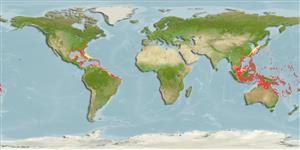Echinoidea |
Camarodonta |
Toxopneustidae
Environment: milieu / climate zone / गहराई सीमा / distribution range
पारिस्थितिकी
प्रवाल-भित्ति संयुक्त; गहराई सीमा 10 - 82 m (संदर्भ 81020). Tropical
Indo-West Pacific.
Length at first maturity / आकार / Weight / Age
परिपक्व अवधि: Lm ? range ? - ? cm
Dwells in hard substrates, among pebbles and rocks. Utilizes a combination of hard debris, shells, pebbles and seaweeds as cover (Ref. 129602). Lives on coral rubble substrates.
Life cycle and mating behavior
परिपक्व अवधि | पुनरुत्पत्ति | मछलीऔ का अंडे देना | Eggs | Fecundity | Larvae
Members of the class Echinoidea are gonochoric. Fertilization is external. Brooding is common, eggs are held either on the peristome, around the periproct or deep into the concavities on the petaloids. Life cycle: Embryos develop into planktotrophic larvae (echinoplateus) and live for several months before they sink to the bottom using their tube feet to adhere on the ground where they metamorphose into young urchins.
de Beer, M. 1990 Distribution patterns of regular sea urchins (Echinodermata: Echinoidea) across the Spermonde Shelf, SW Sulawesi (Indonesia). In pp. 165-174 De Ridder, C., Dubois, P., Layahe, M. C. and Jangoux, M. (eds.). Echinoderm Research. Balkema, Rotterdam. (संदर्भ 81254)
IUCN Red List Status
(संदर्भ 130435: Version 2025-1)
CITES status (संदर्भ 108899)
Not Evaluated
CMS (संदर्भ 116361)
Not Evaluated
Threat to humans
Human uses
| FishSource |
साधन
अधिक जानकारी
Trophic EcologyFood items (preys)
संघटक आहार
आहार खपत
परभक्षी
Population dynamicsबाढ़
Max. ages / sizes
Length-weight rel.
Length-length rel.
Length-frequencies
Mass conversion
बहुतायत
Life cycleपुनरुत्पत्तिपरिपक्व अवधिFecundityमछलीऔ का अंडे देनाEggsEgg developmentLarvae PhysiologyOxygen consumption
Human RelatedStamps, coins, misc.
इंटरनेट स्रोत
Estimates based on models
Preferred temperature
(Ref.
115969): 24.2 - 28.9, mean 27.5 (based on 416 cells).
Price category
Unknown.
